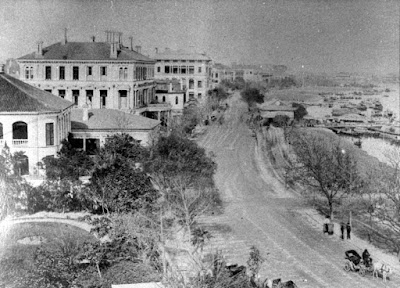I am beginning to understand Clara Telge could well be one of the finest rediscovered ("retrouvé") artists among my private collection of mostly forgotten German woman artists. Today in this Part IV I share some more interesting findings of my research. Many small parts had to come deep from the Internet and puzzling them together is creating a truly fascinating story.
The earliest mentioning of Clara's father Bernard Telge (of who I did not find any specifics in Hamburg yet other then I was able to confirm he had a merchant brother Georg Jr. Telge and his family). I found Telges presence in Yokohama Japan in 1860 as "special agent" of the Hamburg trading firm of Pustau (more later) where he had been the subject of international diplomatic problems and worries which had to do with his "rude and uncivilized behavior" in Yokohama (in the late 1850's !). It has to be said diplomats had in overall rather negative view on all European traders in the Orient. It was reported Telge had "violated" hunting regulations...... Seeing the later succes of his businesses in China he either changed his attitude considerably or one can doubt the "tone" of the written reports. Maybe the truth lies in the middle.
Any way, the "problems, concerns and worries" he'd caused were discussed as far away as in London parliament and were also recorded by the leader of the German East-Asia expedition diplomat Friedrich Albrecht Baron zu Eulenburg (1815-1881) who, returned from his expedition to Japan, was to serve as Prussian minister of the Interior (1862-1878)
Any way, the "problems, concerns and worries" he'd caused were discussed as far away as in London parliament and were also recorded by the leader of the German East-Asia expedition diplomat Friedrich Albrecht Baron zu Eulenburg (1815-1881) who, returned from his expedition to Japan, was to serve as Prussian minister of the Interior (1862-1878)
Since the 16th and 17th centuries several European countries traded with China and Japan but because the Japanese had enough of the constant attempts to convert Japan to Christianity it had limited foreign trading countries to the Dutch and Chinese.
America after annexing California had gained access to the Pacific and seeking trade and coal (bunker) harbors to the West had send two semi military expeditions to Japan to, if necessary with the use of military force, make Japan to open the island to trading. In the second Perry expedition of 1854/55 German/American artist William (Wilhelm) Heine (1827-1885) who was working in the Americas was assigned to the staff as an artist drawer.
 |
| Wilhelm Heine: The second Perry expedition 1855 anchored in Yokohama |
On his return to Germany in the late 1850's Wilhelm Heine with his American expedition expertise was able to persuade the Prussian government to send a German-Prussian expedition claiming and securing "their share" of future business and to avoid monopoly by America and other trading countries. Thus the Prussian Eulenberg expedition was set up. Again the artist Wilhelm Heine travelled to Japan, China and Siam but now at the service of his native Germany.
 |
| The German ships of the 1859 East Asia Expedition. On arrival one ship with its entire crew was lost in a typhoon. |
 |
| Shanghai 1860: "the Bund" location of the foreign trading concessions. |
 |
| Shanghai: the Bund |
 |
| Shanghai: the firm of Bernard Telge (& Schroeter) in the late 19th century |
 |
| Telge & Schroeter: possibly Bernard Telge and Hermann Schroeter) |
All pictures borrowed freely from the Internet for friendly, educational and non commercial use only.
More to follow soon. Readers and passers-by are invited to send all they might know about Clara Telge and her Hamburg (and possibly Berlin) relatives in an attempt to create a first short biography of Clara Telge.






No comments:
Post a Comment